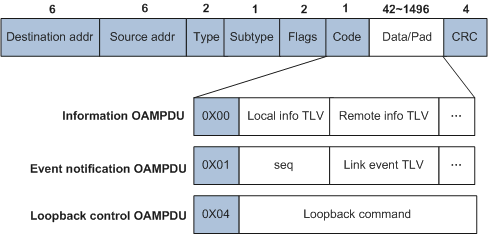Basic Concepts of EFM
OAM PDUs
EFM works at the data link layer and uses protocol packets called OAM Protocol Data Units (PDUs). EFM devices periodically exchange OAMPDUs to report the link status, helping network administrators effectively manage networks. Figure 1 shows the format of an OAMPDU as well as the common types of OAMPDUs. Table 1 describes fields in an OAMPDU.
Field |
Description |
|---|---|
Destination addr |
Destination MAC address, which is a slow protocol multicast address 0x0180-C200-0002. Network bridges cannot forward slow protocol packets. EFM OAMPDUs cannot be forwarded over multiple devices, even if OAM is supported or enabled on the devices. |
Source addr |
Source address, which is a unicast MAC address of a port on the transmit end. If no port MAC address is specified on the transmit end, the bridge MAC address of the transmit end is used. |
Type |
Slow protocol type that has the fixed value of 0x8809. |
Subtype |
Subtype of a slow protocol. The value is 0x03, indicating that the slow subprotocol is EFM. |
Flags |
EFM entity status:
|
Code |
OAMPDU type:
Table 2 describes OAMPDU types. |
OAMPDU Type |
Description |
|---|---|
Information OAMPDU |
|
Event Notification OAMPDU |
Used to monitor links. If an errored frame event, errored code period event, or errored frame second event occurs on an interface, the interface sends an Event Notification OAMPDU to notify the remote interface of the event. |
Loopback Control OAMPDU |
Used to enable or disable the remote loopback function. |
Connection Modes
EFM supports two connection modes: active and passive. An EFM connection can only be initiated by an OAM entity working in active mode. An OAM entity working in passive mode waits to receive a connection request from its peer entity. Table 3 lists capabilities for processing OAMPDUs in the two connection modes.
Capability |
Active Mode |
Passive Mode |
|---|---|---|
Initiate a connection request by sending an Information OAMPDU during the discovery process |
Supported |
Not supported |
Respond to a connection request during the discovery process |
Supported |
Supported |
Send Information OAMPDUs |
Supported |
Supported |
Send Event Notification OAMPDUs |
Supported |
Supported |
Send Loopback Control OAMPDUs |
Supported |
Not supported |
Respond to Loopback Control OAMPDUs |
Supported (The remote EFM entity must work in active mode.) |
Supported |
